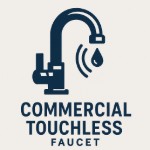Architectural Specification Insights: Building Code-Compliant, Sustainable, and Reliable Restroom Design
A Technical Overview for Architects and Specifiers
The Architecture of Compliance: Understanding cUPC, NSF, and WaterSense in Commercial Faucet Design
In commercial and hospitality design, plumbing fixture selection is a matter of performance, safety, and compliance. The intersection of cUPC, NSF/ANSI 61, NSF/ANSI 372, and EPA WaterSense certifications defines the technical standards for potable water safety and efficiency within the built environment.
The cUPC (Uniform Plumbing Code) certification ensures fixtures meet hydraulic performance, backflow prevention, and installation integrity, providing architects with a uniform benchmark for cross-jurisdictional compliance. NSF/ANSI 61 and 372 focus on material safety — verifying that no harmful contaminants or excessive lead content leach into potable water systems. Meanwhile, WaterSense certification measures conservation and performance, requiring fixtures to reduce flow by at least 30% without compromising user experience.
Collectively, these certifications create a compliance framework that aligns with LEED v4.1, WELL, and CALGreen standards. For architects, they offer a path to verifiable code adherence and design accountability — ensuring that every water delivery point meets both functional and regulatory demands.
Specifying for Performance: Engineering Faucets for High-Traffic Environments
In high-traffic commercial and institutional spaces, performance reliability is paramount. A spec-grade faucet must withstand continuous use, variable pressure, and environmental exposure while maintaining consistent operation. These systems typically feature solid brass construction, industrial-grade solenoid valves, and adaptive sensor calibration capable of adjusting to ambient conditions.
Lifecycle testing, often exceeding 500,000 activations, confirms durability, while internal component modularity ensures maintainability and minimal downtime. Architects specifying such fixtures benefit from predictable performance metrics that support long-term facility management goals.
Additionally, advanced infrared sensing and efficient DC power systems contribute to both hygiene and operational sustainability — ensuring the fixture performs reliably without increasing energy load or maintenance requirements.
Designing for Public Health: The Role of Low-Lead and Touchless Technologies in Modern Infrastructure
Public health design now extends into plumbing infrastructure. Low-lead materials, verified under NSF/ANSI 372, limit lead content to below 0.25%, safeguarding drinking water integrity in schools, hospitals, and other sensitive facilities. The touchless activation of modern faucets further enhances hygiene by reducing cross-contact on shared surfaces — a principle increasingly codified in post-pandemic building standards.
In addition to mitigating microbial transmission, touchless fixtures contribute to energy and water conservation by precisely regulating flow through electronic solenoid valves. For architects, specifying such systems ensures alignment with CDC and ASHRAE guidance on water quality and public health safety, translating design into proactive wellness infrastructure.
Sustainable Water Management Through Specification: Integrating WaterSense Fixtures in Building Design
Water conservation is now intrinsic to design performance. WaterSense-certified faucets — delivering ≤0.5 GPM — align directly with LEED, WELL, and CALGreen prerequisites for indoor water use reduction. These fixtures achieve measurable water savings without diminishing functionality, relying on calibrated aerators, pressure-compensating flow regulators, and smart sensor systems.
Architecturally, specifying WaterSense fixtures integrates sustainability at the system level. Flow regulation and adaptive shut-off functions prevent waste and stagnation, reducing both consumption and microbial risk. Over the life of a large-scale installation, these optimizations can save tens of thousands of gallons annually, contributing to net-zero water and operational cost reduction goals.
Sustainability also extends through materials and lifecycle. Long-lasting components, low-lead alloys, and serviceable design minimize replacement frequency and material waste — reinforcing the principles of circular construction and resource stewardship central to 21st-century architectural practice.
The Specifier’s Guide to Reliability: Ensuring Code-Compliant and Future-Ready Restroom Systems
Reliable restroom design depends on systemic foresight — uniting code compliance, engineering precision, and ease of maintenance. A fully certified faucet (cUPC, NSF/ANSI 61, 372, and WaterSense) meets all core regulatory requirements while maintaining interoperability with ADA and Title 24 provisions.
Reliability also manifests in design coordination. Modular component assemblies simplify service, while BIM and Revit data integration supports interdisciplinary collaboration between architects and MEP engineers. This facilitates clash-free installation, standardized detailing, and submittal documentation clarity.
In sustainable design frameworks, reliability equates to resilience. Systems that minimize service needs and maintain consistent performance under high use contribute to both occupant satisfaction and long-term resource conservation — two pillars of architectural integrity.
Conclusion
From compliance to sustainability, performance, and reliability, today’s faucet specification represents a synthesis of engineering and design responsibility. The technical parameters discussed — cUPC, NSF/ANSI, WaterSense, and low-lead compliance — collectively define a fixture not as a decorative accessory, but as an integral system within the architectural ecosystem.
Manufacturers such as FontanaShowers have engineered their Fontana Touchless systems around these principles — uniting potable water safety, hygiene, efficiency, and longevity within a code-compliant framework. For architects, understanding and specifying to these standards ensures not only regulatory success but also contributes to the creation of built environments that are sustainable, health-conscious, and enduring by design.

Leave a Reply